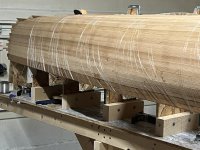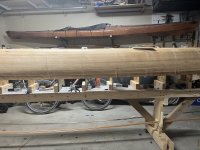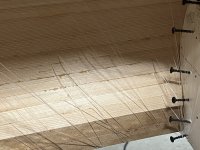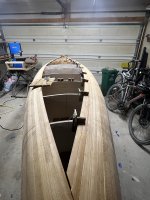A few concerns, that you might answer ?
Does the fish line stay between the strips when you sand ?
Is it visible, after glassing ?
Were your fingers sore from pulling the line tight ?
Will the string would let the beads fit tight in the coves, and making a tight glue joint ?
Thanks !
Jim
Hi Jim. Sorry for the delay in answering your questions. Not finished yet (4 more strips to close in the bottom), so can only give a partial response
1) Once done, the fish line is just cut across the whole sheer line and then pulled out strand by strand from between the strips. So no, they are not there when you sand. On the test panel I did the line came out very easily with a gentle tug, so hopefully there will be no issues for the real deal.
2) The only marks that I can see so far are some slight gouges at the tops of each bead (planking has to be bead up) from the line cutting into it as you pull it tight. You can see this is the photo below. These gouges are covered by the cove on the next strip up, so shouldn’t be visible afterwards. It looks like the lines will however also leave some very slight marks in the coves as well, but these are so faint that they will disappear with normal sanding.

@
3) No real cutting/soreness in my fingers - I just unrolled the line from the spool it came on, which also gives a comfortable grip to pull things tight. Good idea to clamp the line that goes over the top of each strip as you go, so if you somehow drop the spool and wind up chasing it across the garage floor as it unrolls 20 feet of line, you don’t lose the tension in everything you have done before (ask me how I figured this out).
4) The line does allow a tight fit between strips as far as I can tell - good squeeze out and the joints look fine. As noted above, the lines basically cut a little gouge in the bead so that they wind up flush with the surface, so don’t interfere.
Once I finish the planking the bottom and pull the line out I will give an update if any of this changes.
Brian - yes, it is fiddly - not sure I would do it again, but it does work well for at least the tricky strips around the tumblehome. Night and day shifting to the L blocks and clamps for the bottom - so much faster and easier to install each strip. But once you factor in the per-strip wait time for glue to dry (which you don’t really need with the fishing line approach since it lets you do up to probably 3 or 4 strips per session) I am not sure it is all that much faster overall, just easier.
All that said, after almost three weeks of this I am coming to the conclusion that for me at least, life is too short to park your staple gun. It’ll be out again for my next build.
thanks
Tony





